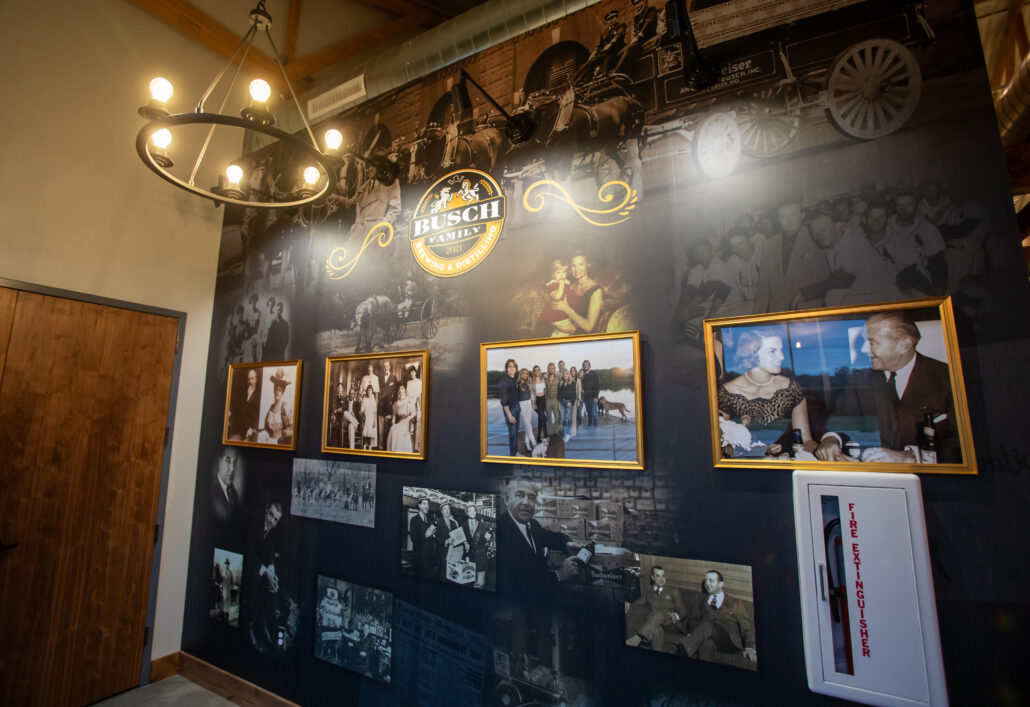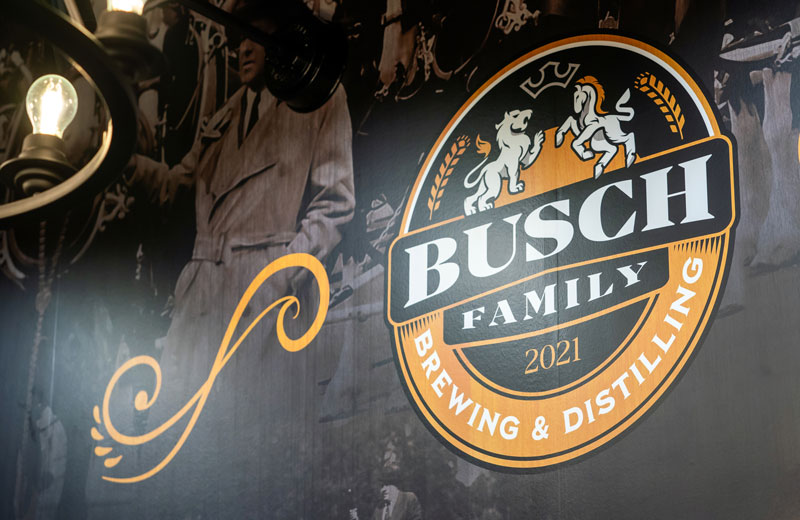Anyone familiar with St. Louis’s history knows the impact the Busch family has on this region. Grant’s Farm, Busch Stadium, and the Anheuser-Busch Clydesdales are some of the hallmarks of living under the Arch’s shadow, and St. Louis wouldn’t be the same without this historical family’s influence.
However, when family legacies get distilled into the iconic establishments (and beverages) that give a city character, many of the people involved get left out of the story. Behind the landmarks lives a real family celebrating, mourning, and making memories together.
Tim Eagan, president of Eagan Building Group, took time to speak with me about his work with Billy Busch on a recent project: Busch Family Brewing & Distilling, established in 2021 on the Busch Family Farm in Defiance, Missouri. Anderson Archival recently contributed to this effort by digitizing one-of-a-kind Busch family artifacts that show a side of the local legends never before seen by the public.
AA: Can you start by telling us a little about your business?
We started in 2008 and have been in business for 16 years now. We focus primarily on design-build construction for commercial and industrial construction sectors.
AA: How does the design-build process differ from the typical design-bid-build method?
The number one pro is scheduling, because it allows us to move a lot more quickly through the design process, to better gauge the design, or better tailor the design to the budget. Since we’re working side by side with the customer, we have an understanding of their budget, and it provides a lot of transparency. The customer has to be willing to trust us and make sure that we are working for their benefit.
Another one is just the level of engagement that a customer has. With a design build format, you’re really in the trenches with the contractor, architects, and the owner all at the same time. We’re planning it out in real time, showing the customer 3D renderings of it before we’ve completed construction documents. That’s really helpful because so many people can’t visualize what a 2D drawing will look like.

AA: Let’s talk about Busch Family Brewing & Distilling. How did Eagan Building Group get involved?
An architect had already been engaged by Billy Busch to work on it. He thought that it would really benefit Billy to have visualization for it, so it evolved into a design-build project once I was brought in to help build these visualizations.
The property that the brewery is built on was the former location of the Bridlespur Hunt Club in Defiance, where the St. Louis aristocracy going back several generations used to fox hunt. In 2006, they relocated to get a little bit further out [from the growing city] and Billy [Busch] purchased [the property] just as a private property to hunt and fish on. He’s got kind of his own little Grant’s Farm out there with Clydesdales, alpacas, sheep, and some other different types of animals.
Brewing is obviously in his blood, and he wanted his family to get back into the business. They’ve got such a legacy of brewing and he wanted to continue that tradition, so he got back into it [with Busch Family Brewing & Distilling]. A lot of his beers are a homage to his ancestry; one of his beers is named “Gussie” and another one is “Adolphus,” referencing his ancestors.
AA: How did digitization fit into this project?
Billy knew from the beginning that he wanted to incorporate his history, but he didn’t really know how or what it would look like. He just knew he wanted to have his family’s history really ingrained into this project.
He has a family archive, a garage storage unit completely full of Busch family history. We went there with him and helped pick out a lot of the things that will be featured in the brewery. We probably didn’t even touch a fraction of a fraction of it—there’s so much more there. It was very cool, seeing all of these artifacts from Busch family history: things that his dad used, called bung hammers, to tap a keg; the hammer his dad used when Anheuser-Busch brewed their 10 millionth barrel of beer. And then on the backside of that we actually walked through the original Anheuser Busch brewery with them as well. It was kind of neat walking in the hallways there with a direct Busch descendant.

AA: How did you select the materials that were chosen to support this project?
Part of it was that he wanted to show a more personal side of his family. You know, everybody’s seen a lot of photos of the Busch family if you live in St. Louis. They have a very public face. Obviously, again, there’s a lot of history there. A couple of those photos are more recognizable just because they’re such milestone photos. The bulk of the photos that have been incorporated into [the new brewery] are really all about family. Billy’s very tight with his family and he wanted to show that.
AA: Had you ever utilized digitization before in a project like this?
No, this was my first actual exposure to it. Pretty much all I knew was that the industry exists, but that was about it. We had a graphic designer that we retained to mock up a concept of what the photo wall was actually going to look like. From there, we tried to tailor the photographs that we selected for that to what the concept looked like.
Once we had that figured out, we needed high resolution images of [the artifacts] in order to make it work because, obviously, we’re blowing it up in a pretty large format. They’re taking photos that are 8×10” and making them 18×30”. Any time you blow up a photo, it’s easy for it to get pixelated, so it was really important that we have very high resolution.
“Any time you blow up a photo, it’s easy for it to get pixelated, so it was really important that we have very high resolution.” – Tim Eagan
AA: How did you find Anderson Archival and decide we were the right fit to help?
There’s not a ton of digital restoration people out there that I found, but of the ones that I did, Anderson Archival definitely stood head and shoulders above everybody else just in the way you present yourselves online, your image and professionalism. Everything was as I expected it to be.
AA: Do you have advice for others considering incorporating these types of historical artifacts into construction projects?
Try to work on that part of it as early in the process as possible. When you’re doing digital restoration for display, that’s something that you want to be very visible and very front and center. It has such a visual impact in the space. Billy’s very in tune with his family legacy, so trying to incorporate that as much as possible is really stunning. It becomes something that you want to design around. You don’t want it to be an afterthought. We want it to be something that’s deliberate from the very beginning and then everything else works around it.
Thank you to Tim Eagan for his contribution to this piece. Read more about the construction project here. Anderson Archival is very grateful for the opportunity to help share another chapter of the Busch family history!
Ready to tell your own family’s story through digitization or digital restoration? Contact us via the button below.


